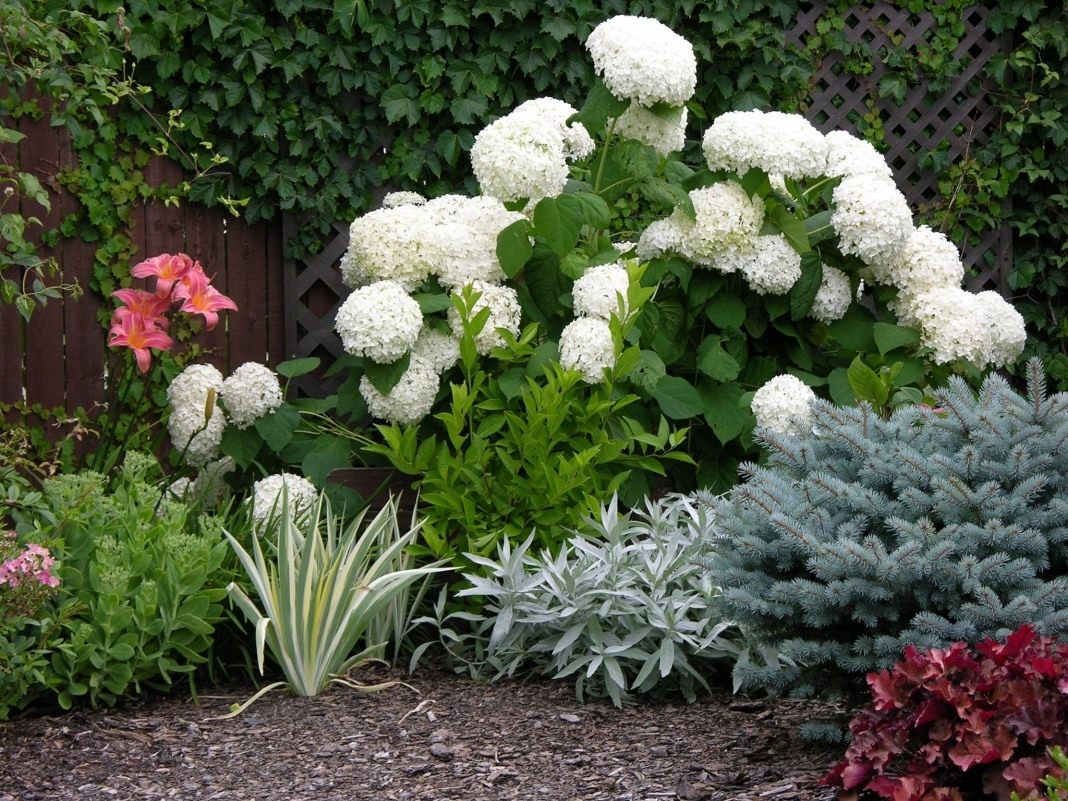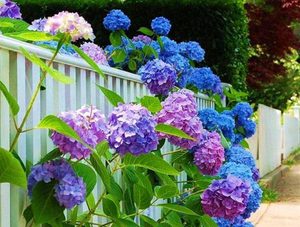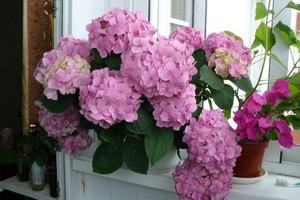Delicate and bright airy hydrangea inflorescences will give the garden its own style and mood of comfort. An ideal option for realizing your design fantasies is panicle hydrangea. In addition to the fact that the plant blooms profusely and is very unpretentious, it lends itself well to formation. Even standard forms can be created from bushes of this type, which will persist for many years. This feature of the panicle hydrangea makes it ideal for decorating any garden area. In this article, we will look at the best flower varieties and talk about the features of growing them outdoors.
Content
Description, photos and types of hydrangeas
Today, there are more than eighty types of hydrangeas, of which more than one hundred hybrid varieties have been bred by breeders. There are erect and curly, evergreen and deciduous, treelike and dwarf, thermophilic and frost-resistant hydrangeas.
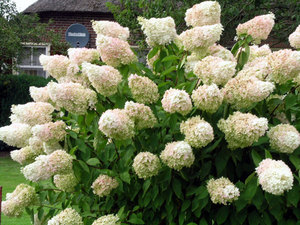 The leaves of the plant can be oval or round, with jagged edges or wavy. Depending on the type and variety, the inflorescences are formed in the form of a panicle, cone, umbrella or ball. At the edges of each inflorescence are sterile flowers with four petals, and in the center are fruiting flowers. Hydrangea blooms for a long time with white, red, lilac, blue, purple, bright crimson or deep pink flowers... Their palette can have transitional shades or consist of two colors.
The leaves of the plant can be oval or round, with jagged edges or wavy. Depending on the type and variety, the inflorescences are formed in the form of a panicle, cone, umbrella or ball. At the edges of each inflorescence are sterile flowers with four petals, and in the center are fruiting flowers. Hydrangea blooms for a long time with white, red, lilac, blue, purple, bright crimson or deep pink flowers... Their palette can have transitional shades or consist of two colors.
The most popular hydrangea is large-leaved with spherical inflorescences, which in the 18th century from Japan came to Europe, where it made a sensation. This plant was grown only at home as it was thermophilic. Since then, breeders have brought out the widest selection of varieties and types of hydrangeas that are hardy and can grow in open ground in almost any latitude.
Hydrangeas: species and varieties for Russian gardens
In the gardens of our climatic zone, hydrangeas are widespread and winter well: tree, paniculate and serrate.
Hydrangea tree-like or wild is a bush up to 2.5 meters high with pointed leaves and huge dense inflorescences of different colors. The species is considered winter-hardy and unpretentious, due to which it is widely used for decorating garden plots in the middle latitudes of our country. She does not need shelter, prefers semi-shady and shady areas.
 Serrated hydrangea is medium-sized tree-like spreading shrub up to one and a half meters high... Its bright green oval leaves are pointed towards the top. Inflorescences in the form of a ball are made up of blue flowers. The brightness of their color depends on the acidity of the soil. Fading, the petals turn pink. The serrata hydrangea flowers bloom in mid-summer and bloom until September. The species is suitable for growing in the middle zone of our country, but requires shelter for the winter.Loves moderate watering and tolerates any transplants well.
Serrated hydrangea is medium-sized tree-like spreading shrub up to one and a half meters high... Its bright green oval leaves are pointed towards the top. Inflorescences in the form of a ball are made up of blue flowers. The brightness of their color depends on the acidity of the soil. Fading, the petals turn pink. The serrata hydrangea flowers bloom in mid-summer and bloom until September. The species is suitable for growing in the middle zone of our country, but requires shelter for the winter.Loves moderate watering and tolerates any transplants well.
Paniculata hydrangea is an incredibly beautiful plant and is one of the most popular species in garden culture. A small tree in the open field will grow from two to five meters. Cold resistance is given to it by shoots, which quickly grow stiff. The pubescent leaves up to 12 cm long are elliptical. The panicle-shaped inflorescences are composed of fragrant flowers that make excellent honey plants. Flowering begins in June and lasts until frost. The species is suitable for cultivation in the central and northern part of Russia, because without shelter it can withstand frosts down to -25C. Hydrangea paniculata has a large number of the most diverse varieties, among which it can be noted:
- Variety "Grandiflora" - it is a massive shrub with oblong velvety leaves and large, white inflorescences that turn pink over time. On fertile, light and well-moistened soils, it grows up to two meters. Does not like strong winds, but tolerates frosts well.
- Variety "Vanilla Fries" is a spreading bush up to two meters high. The lush inflorescences consist of white flowers that later turn bright pink. Blooms late. Loves light and moisture. It easily tolerates severe frosts.
- Variety "Great Star" differs in oval shiny leaves and small inflorescences with large flowers. Their four petals create a propeller-like appearance and bloom in the second half of summer. The variety is frost-resistant, but requires shelter for the winter.
- Variety "Bobo" refers to dwarf forms that do not grow up to one meter. Blooms in the second half of summer with lush inflorescences of pink, white and light yellow shades. For the winter it is mulched with leaves. Suitable for decorating flower beds and small front gardens.
- Variety "Unique" grows up to two meters and decorates gardens with its exquisite appearance. The spreading bush is covered with boiling-white inflorescences, which turn pink by the end of flowering. Young plants take cover for the winter.
- Variety "Phantom" is such an abundantly flowering shrub that, due to its large white inflorescences and creamy flowers, almost no leaves are visible. To make the flowering even more magnificent, in the spring the shoots are cut shortly.
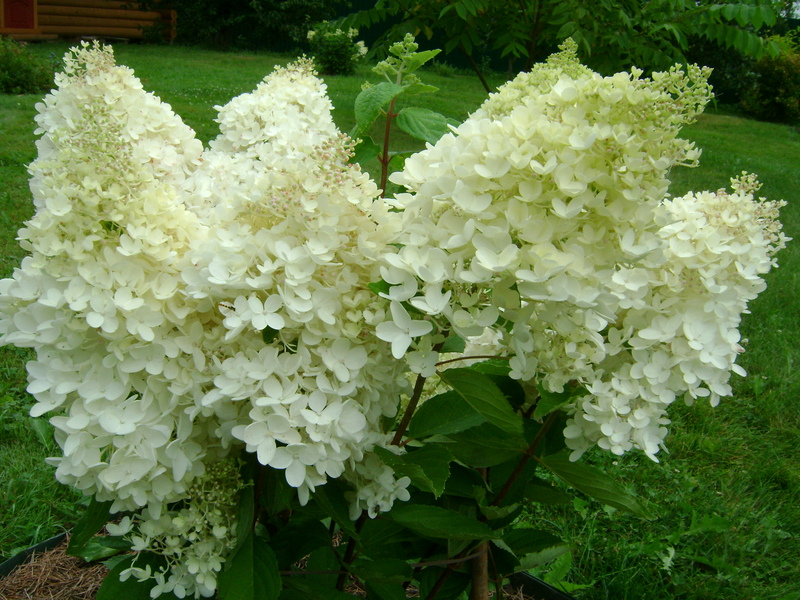
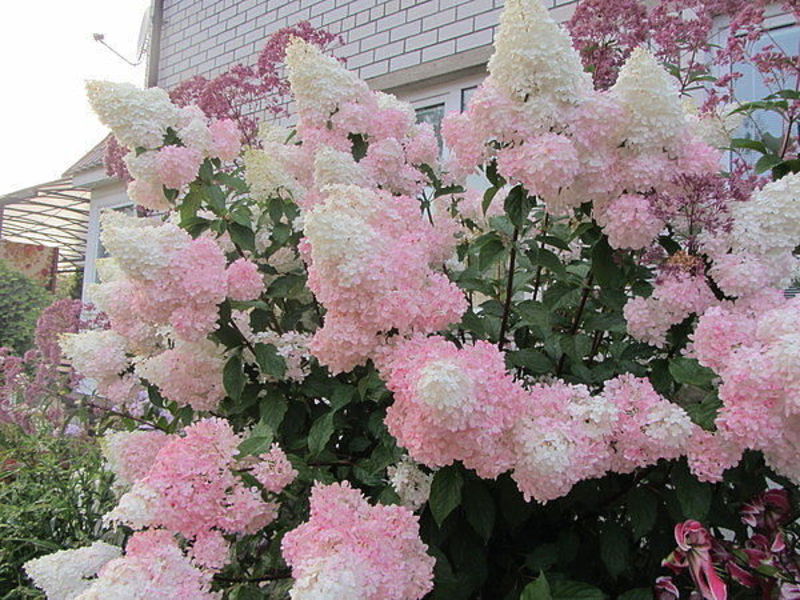
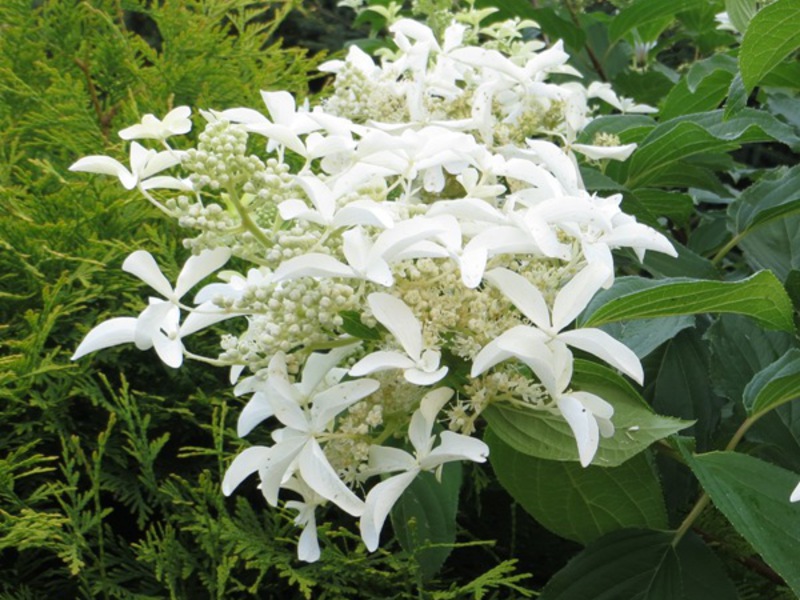
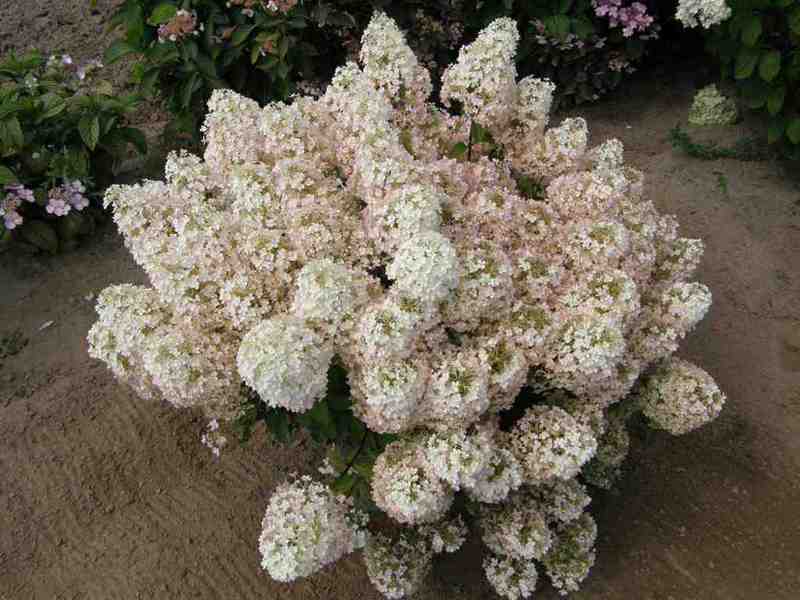
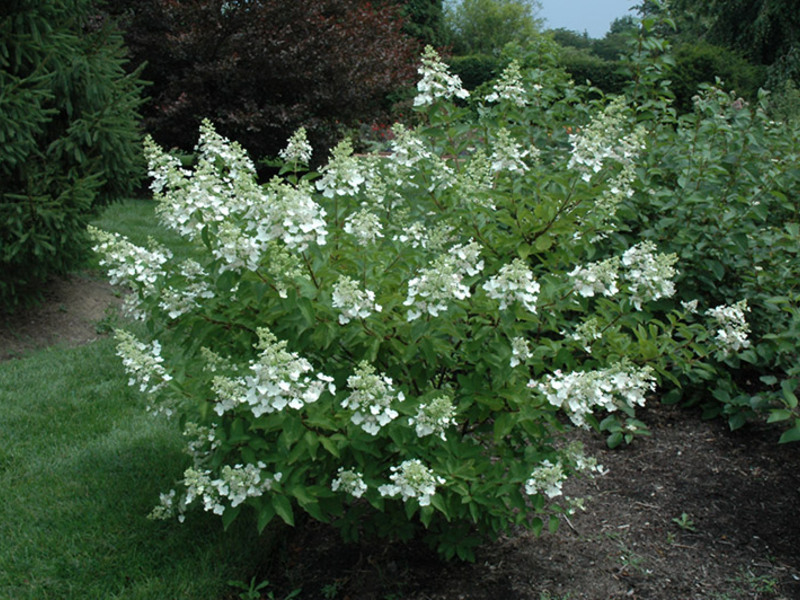
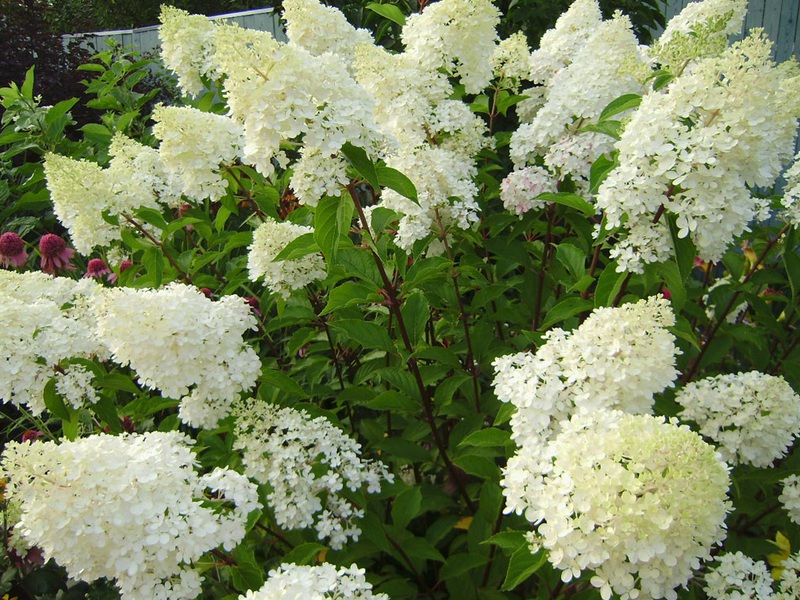
Planting hydrangeas in open ground
Hydrangeas are planted in well-lit areas without direct sunlight. They grow best in partial shade on well-drained, loamy, structural soils. The soil should have an acidic or neutral reaction, since on alkaline soils the plant gets sick, grows poorly and practically does not bloom from a lack of iron.
Planting flower seedlings is done just before the buds are set. A mixture of manure with bone meal is introduced into the holes prepared according to the size of the root system or a ready-made feed for hydrangeas. The plant is carefully removed from the container and placed in the hole together with the earthen lump. The roots are covered with soil and pressed slightly. After planting, the hydrangea must be watered abundantly.
The color of flowers directly depends on the acidity of the soil. To obtain bright blue inflorescences, aluminum salts are added to the alkaline soil. In acidic soil, pink flowers can be obtained after adding limestone.
Panicle hydrangea: care
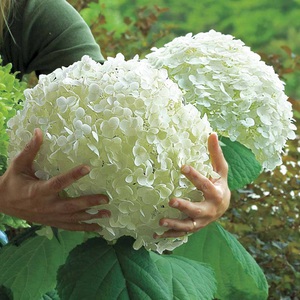 The shrub is unpretentious, therefore, special knowledge and skills are not required when caring for it. Translated from Greek, the name of the flower means "a vessel with water", which speaks of the main conditions of its life. Therefore, it is necessary to water the hydrangea often and abundantly. The ground should be constantly wet, but so. So that there is no stagnation of water in it.
The shrub is unpretentious, therefore, special knowledge and skills are not required when caring for it. Translated from Greek, the name of the flower means "a vessel with water", which speaks of the main conditions of its life. Therefore, it is necessary to water the hydrangea often and abundantly. The ground should be constantly wet, but so. So that there is no stagnation of water in it.
To facilitate care when planting moss or hydrogel can be added to the hole along with the root system... They are able to retain moisture and prevent the soil from drying out during the hot season.
Fertilizing hydrangea
When caring for a plant, one should not forget about its fertilization, on which active growth and flowering depend. Three dressings are done during the season:
- In the spring, at the beginning of the growing season, the plants, the bushes are fed with nitrogen fertilizers. Young bushes are fertilized a few days after planting.
- Before flowering, around June, nitrogen fertilizers are again applied.
- In September, when the plant begins to fade, the garden hydrangeas are fed with potassium salt.
Pruning bushes
Pruning shrubs is a very important part of maintenance, as improperly done shrub can damage the shrub or lead to poor flowering.
Features of hydrangea pruning:
- Old inflorescences are removed until healthy and strong buds.
- In hydrangea paniculata last year's shoots are cut off only by a third.
- Too densely spaced and weak branches are cut under the root.
- In relatively mild climates, pruning is recommended before the active growing season begins in the spring. This is due to the fact that dried hydrangea inflorescences not only look beautiful in the winter garden, but also protect new buds from frost.
Preparing hydrangea paniculata for winter
 Frost-resistant shrub survives frosts well. However, in regions with harsh winters, it must be sheltered. Frozen shoots in spring quickly recover and grow back, so you can only cover the root system. To do this, the base around the bush is spud and covered with mulch.
Frost-resistant shrub survives frosts well. However, in regions with harsh winters, it must be sheltered. Frozen shoots in spring quickly recover and grow back, so you can only cover the root system. To do this, the base around the bush is spud and covered with mulch.
In winters with temperatures below -35C, the whole bush is insulated... Adult plants are bound and wrapped in spunbond or lutrasil. Then a frame is erected around them, the interior of which is filled with dry foliage or straw. Young plants are pressed to the ground and covered with roofing material, which is pressed down with bricks or boards.
Caracas is removed from the bushes in April, and the covering material is removed only after the last frosts have passed.
Reproduction of hydrangea paniculata
Reproduction is carried out in three ways:
- layering;
- cuttings;
- shifts.
Cuttings
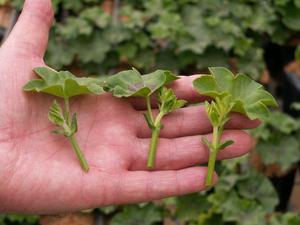 When pruning the plant, there are sections of shoots that can be rooted. To do this, they are first put in water for several days, and then cuttings are cut. In a soil consisting of sand and peat, cuttings are planted two-thirds of the entire length... The container is covered with polyethylene and placed in a cool place. Cutting care is about keeping the soil moist. It shouldn't dry out. Thus, the cuttings are rooted and stored until spring. Young plants planted in open ground must take shelter for the winter for three years.
When pruning the plant, there are sections of shoots that can be rooted. To do this, they are first put in water for several days, and then cuttings are cut. In a soil consisting of sand and peat, cuttings are planted two-thirds of the entire length... The container is covered with polyethylene and placed in a cool place. Cutting care is about keeping the soil moist. It shouldn't dry out. Thus, the cuttings are rooted and stored until spring. Young plants planted in open ground must take shelter for the winter for three years.
Green cuttings cut in summer are rooted in an earthy mixture with a top layer of sand. Twigs should not reach the peat.
Reproduction by layering
To get a young plant, a depression is made in the soil next to a large bush. The soft young shoot is bent down and covered with a layer of earthen mixture. Placed next to support to which the middle part of the retracted shoot is tied... It will be possible to separate a young plant from the mother bush only after the twig gives roots and begins to grow. This will not happen earlier than in a year.
In order for cuttings and shoots to take root well and quickly, it is recommended to use a growth stimulant when rooting.
Seed reproduction
Species hydrangeas reproduce by seeds. Sowing is carried out in autumn in seedling containers filled with an earthen mixture consisting of leafy soil, peat and coarse sand (4: 2: 1). The seeds are sprinkled with a small layer of soil and moistened with a spray bottle. In order for the seedlings to sprout together, it is recommended to cover the containers with foil or glass. The mini greenhouse is placed in a warm place with an air temperature of 14-20C. The film or glass must be removed for half an hour every day, ventilating the substrate. In this case, you must ensure that it is always wet.
The first shoots appear no earlier than a month later. The film is immediately removed, and the containers are placed in a well-lit place... When the first true leaves appear, the seedlings dive for the first time. The second time they sit in separate pots at the end of spring.
As soon as young plants get stronger, they need to start hardening. On warm days, the bushes are exposed to fresh air in a place protected from direct sunlight, wind and rain. To prevent young plants from being weakened by flowering, the buds that appear are removed. In open ground, hydrangea grown from seeds is planted only two years after sowing.
In the garden of a real owner, who will love the plant and take care of it with pleasure, panicle hydrangea will surely take root and give the flower garden a unique look.
